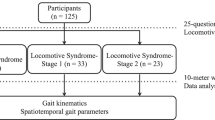Abstract
A person’s gait is their walking pattern. Walking necessitates muscular coordination and balance for the body to move forward rhythmically. Gait disorder is an issue in human society that can limit a person’s life activity as an injury. Proper and rapid diagnosis of this disorder can help the healing process. Therefore, several types of research have always been done to identify the disorder, based on which the physician can consider an appropriate treatment plan for the patients. In this study, a Kinect sensor that has the ability to identify 25 points of anatomical points of the body has been used to receive and record data, Using the Kinect sensor to monitor and control gait disorder is cheaper than other existing systems. Also, it offers a higher quality in recording activities and feedback, which can show the desired indicators more accurately about the patient’s gait disorder. The proposed method is defined based on a Fuzzy inference system defined by a medical team consisting of Medical Doctor Orthopedic and medical doctors as experts in this system. We gather data from 90 participants as a data set and then divided it randomly into two groups, 45 participants for the Fuzzy inference system construction as training step and 45 participants for the Fuzzy inference system evaluation as a test step. The outputs of the Fuzzy system validation show that based on three-dimensional information, 7 extracted features and rules made in the Fuzzy inference system, the accuracy is 95.1% .

















Similar content being viewed by others
References
Ahmadi M, O’Neil M, Fragala-Pinkham M, Lennon N, Trost S (2018) Machine learning algorithms for activity recognition in ambulant children and adolescents with cerebral palsy. J Neuroeng Rehabil 15(1):105. https://doi.org/10.1186/s12984-018-0456-x
Alabbasi H, Gradinaru A, Moldoveanu F, Moldoveanu A (2016) Human motion tracking & evaluation using Kinect V2 sensor, 2015 E-Health Bioeng. Conf. EHB 2015, https://doi.org/10.1109/EHB.2015.7391465
Alexander NB, Goldberg A (2005) Gait disorders: search for multiple causes. Cleve Clin J Med 72(7):586–586. https://doi.org/10.3949/ccjm.72.7.586
Baker JM (2018) Gait Disorders. Am J Med 131(6):602–607. https://doi.org/10.1016/j.amjmed.2017.11.051
Bari ASMH, Gavrilova ML (2019) Artificial neural network based gait recognition using Kinect sensor. IEEE Access 7:162708–162722. https://doi.org/10.1109/ACCESS.2019.2952065
Bei S, Zhen Z, Xing Z, Taocheng L, Qin L (2018) Movement disorder detection via adaptively fused gait analysis based on Kinect sensors. IEEE Sensors J 18(17):7305–7314. https://doi.org/10.1109/JSEN.2018.2839732
Desjardins AM, Schiller M, Eraqi E, Samuels AN, Galen SS (2016) Validity of a wireless gait analysis tool (Wi-GAT) in assessing spatio-temporal gait parameters at slow, preferred and fast walking speeds. Technol Heal Care 24(6):843–852. https://doi.org/10.3233/THC-161232
Ebersbach G, Sojer M, Mller J, Heijmenberg M, Poewe W (2000) Sociocultural differences in gait. Mov Disord 15(6):1145–1147. https://doi.org/10.1002/1531-8257(200011)15:6<1145::AID-MDS1013>3.0.CO;2-C
Eltoukhy M, Oh J, Kuenze C, Signorile J (2017) Improved kinect-based spatiotemporal and kinematic treadmill gait assessment. Gait Posture 51:77–83. https://doi.org/10.1016/j.gaitpost.2016.10.001
González I, López-Nava IH, Fontecha J, Muñoz-Meléndez A, Pérez-SanPablo AI, Quiñones-Urióstegui I (2016) Comparison between passive vision-based system and a wearable inertial-based system for estimating temporal gait parameters related to the GAITRite electronic walkway. J Biomed Inform 62:210–223. https://doi.org/10.1016/j.jbi.2016.07.009
Hazra S, Pratap AA, Tripathy D, Nandy A (2021) Novel data fusion strategy for human gait analysis using multiple kinect sensors. Biomed Signal Process Control 67:102512. https://doi.org/10.1016/j.bspc.2021.102512
Huitzil I, Dranca L, Bernad J, Bobillo F (2019) Gait recognition using fuzzy ontologies and Kinect sensor data. Int J Approx Reason 113:354–371. https://doi.org/10.1016/j.ijar.2019.07.012
Lee L, Grimson WEL (2002) Gait analysis for recognition and classification, Proc. - 5th IEEE Int. Conf. Autom. Face Gesture Recognition, FGR 2002, pp. 155–162, https://doi.org/10.1109/AFGR.2002.1004148
Li S, Cui L, Zhu C, Li B, Zhao N, Zhu T (2016) Emotion recognition using Kinect motion capture data of human gaits. PeerJ 9:2016. https://doi.org/10.7717/peerj.2364
Liu H, Rodríguez RM (2014) A fuzzy envelope for hesitant fuzzy linguistic term set and its application to multicriteria decision making. Inf Sci (Ny) 258:220–238. https://doi.org/10.1016/j.ins.2013.07.027
Mahlknecht P et al. (2013) Prevalence and Burden of Gait Disorders in Elderly Men and Women Aged 60–97 Years: A Population-Based Study. PLoS One 8(7), https://doi.org/10.1371/journal.pone.0069627
Marino FR et al. (2019) Gait Speed and Mood, Cognition, and Quality of Life in Older Adults With Atrial Fibrillation. J Am Heart Assoc 8(22), https://doi.org/10.1161/JAHA.119.013212
Pfitscher M, Welfer D, do Nascimento EJ, Cuadros MADSL, Gamarra DFT (2019) Users activity gesture recognition on kinect sensor using convolutional neural networks and fastDTW for controlling movements of a mobile robot. Intel Artif 22(63):121–134. https://doi.org/10.4114/intartif.vol22iss63pp121-134
Pirker W, Katzenschlager R (2016) Gait disorders in adults and the elderly. Weiner Kinische Wochenschrift 129(3):81–95
Pua YH et al (2020) Machine learning methods are comparable to logistic regression techniques in predicting severe walking limitation following total knee arthroplasty. Knee Surgery, Sport Traumatol Arthrosc 28(10):3207–3216. https://doi.org/10.1007/s00167-019-05822-7
Schneider B, Banerjee T (2018) Activity recognition using imagery for smart home monitoring. Stud Comput Intell 730:355–371. https://doi.org/10.1007/978-3-319-63754-9_16
Ťupa O et al. (2015) Motion tracking and gait feature estimation for recognising Parkinson’s disease using MS Kinect. Biomed Eng Online 14(1), https://doi.org/10.1186/s12938-015-0092-7
Wang N, Lin G, Zhang X (2020) Human Gait Analysis Method Based on Kinect Sensor, in Lecture Notes in Computer Science (including subseries Lecture Notes in Artificial Intelligence and Lecture Notes in Bioinformatics), 12595 LNAI, 489–502, https://doi.org/10.1007/978-3-030-66645-3_41
Xu X, McGorry RW, Chou LS, Lin JH, Chang CC (2015) Accuracy of the Microsoft Kinect™ for measuring gait parameters during treadmill walking. Gait Posture 42(2):145–151. https://doi.org/10.1016/j.gaitpost.2015.05.002
Y I et al. (2018) A gait analysis using wearable devices on activities of daily life in patients with knee osteoarthritis. Osteoarthr Cartil 26, S385--S386, [Online]. Available: http://www.embase.com/search/results?subaction=viewrecord&from=export&id=L622574989
Author information
Authors and Affiliations
Corresponding author
Additional information
Publisher’s note
Springer Nature remains neutral with regard to jurisdictional claims in published maps and institutional affiliations.
Rights and permissions
About this article
Cite this article
Khaleghi, E., Soltanizadeh, H., Gholizade, M. et al. Detection of gait disorders in people with a walking disability. Multimed Tools Appl 81, 27969–27989 (2022). https://doi.org/10.1007/s11042-021-11750-x
Received:
Revised:
Accepted:
Published:
Issue Date:
DOI: https://doi.org/10.1007/s11042-021-11750-x




